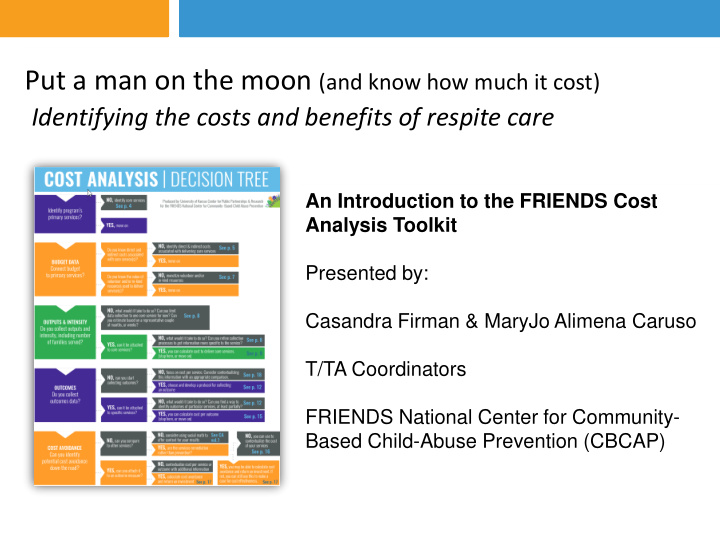



Put a man on the moon (and know how much it cost) Identifying the costs and benefits of respite care An Introduction to the FRIENDS Cost Analysis Toolkit Presented by: Casandra Firman & MaryJo Alimena Caruso T/TA Coordinators FRIENDS National Center for Community- Based Child-Abuse Prevention (CBCAP)
Goals Orientation to Demonstration & Introduction to new FRIENDS Application of the cost analysis cost analysis materials resources
What is cost analysis? Cost analysis is used to accurately identify the full cost of providing a service Simplest forms provide an accurate estimate of the cost of delivering services, incorporating: • direct costs • indirect costs • a measure of the reach of service (e.g. numbers of families served) More sophisticated analyses estimate: • cost avoidance • return on investment
Why do it? Requirements Balance awareness of revenues with costs Cost as a metric everyone understands Way to talk about value, particularly in the context of scarcity Take part in a conversation that is already taking place
Scope of the Resources from FRIENDS Materials on cost analysis for prevention programs such as respite that will help them: • Collect appropriate data • Produce accurate estimates for cost of delivering services • Estimate cost avoidance and/or return on investment Series of briefs, guides, and template
The Materials The Practitioner’s The Practitioner’s Costing template Guide to Cost Guide to Cost in excel and Analysis Part 2: Analysis: First calculating pdf Conducting Your Steps formats First Cost Analysis Readiness Section on Social Missouri Case Assessment Math Study Decision Tree
Where to find them https://friendsnrc.org/activities-that-support-collaboration/cost-analysis
THE PRACTITIONER’S GUIDE TO COST ANALYSIS FIRST STEPS
Creating stakeholder buy-in • Key points: – Discuss the process with service providers and other stakeholders ahead of time, and incorporate their feedback – Encourage providers to think of time spent on CA as crucial to your program’s ability to continue, grow, and thrive – Provide talking points for explaining the importance of data collection to families – Identify how program data will be analyzed and reported – Protect client confidentiality and establish clear parameters for data access
Data collection and processing • Key points: – Use existing data sources where possible to eliminate redundancy in collection – Identify collection tools that ensure data quality and comprehensiveness – Ensure all costs (direct and indirect) are accurately and fully representative – Identify outcomes you currently or would like to measure, and consider how they could be attached to cost – Don’t lose sight of less tangible outcomes
Communication and using results • Key points: – Involve families in the process – Place results in the proper context – Use appropriate language for your audience – Try using social math as a way to communicate numbers meaningfully – Look for savings to the community, state, or society at large – Examine data on program impact and effectiveness – Use clear evidence of programmatic value to pursue new sources of funding and evaluate future allocations
THE PRACTITIONER’S GUIDE TO COST ANALYSIS PART 2: CONDUCTING YOUR FIRST COST ANALYSIS
PART 2 Overview • A practical guide to making analytical choices and calculating figures • Sections include: – Direct, indirect, and in-kind costs – Calculating cost to deliver services – Calculating cost per outcome – Calculating cost avoidance – Readiness assessment decision tree
Direct, indirect, in-Kind costs Detailed discussions of when and how to include each in a Distinctions between direct cost analysis, including: costs, indirect costs, and in- kind resources with examples • How to assign indirect costs across multiple services of each • When you would want to include in- kind resources, and how to do it
Calculating cost to deliver service Incorporating variation in time spent serving Discussion of outputs and intensity families due to differing needs and attrition
Calculating cost per outcome Distinguishing Calculating between Choosing an cost avoidance outputs and outcome and return on outcomes investment
Cost Analysis Rules • Denominators must match : any calculations incorporating multiple pieces of data must share a common metric (such as costs and families served per year ) • When you have to make an assumption (and you will), you just have to make sure it’s logical, appropriate to the nature of your service, and easily explained. • When in doubt, choose the conservative option . It is always better to overestimate the cost of your service and underestimate cost avoidance. • Document, document, document! Keep notes on the sources of all data you use, all calculations you perform, and all decisions you made and the reasoning behind them.
Readiness Assessment Breaks down multiple pieces that decision tree need to be in place to estimate and contextualize cost Creates linear decision-making path: • What kind of data do you currently have available to you? • What should be your next steps? • What do you want to know more about? Can use to navigate the guide
COSTING TEMPLATES
Costing Templates Calculates cost per family served to deliver a service Incorporates direct and indirect costs and in-kind resources Second sheet calculates families served proportionally depending on dosage Available in Excel and PDF
Final thoughts • Your estimates are as good as your data. Most cost analyses involve thoughtfully incorporating multiple sources of data. The more complete your data are, the better your estimates will be. • Don’t let the numbers speak for themselves. Contextualize and communicate the meaning of your results -- your audience probably doesn’t know what is “good,” reasonable, or typical. • Costs are investments. Find a way to convey what we (the funder, the community, etc.) are getting for investing in your program.
Contact Us with questions! Casandra Firman FRIENDS National Center for CBCAP Cfirman@friendsnrc.org MaryJo Alimena Caruso FRIENDS National Center for CBCAP mjcaruso@friendsnrc.org
Recommend
More recommend